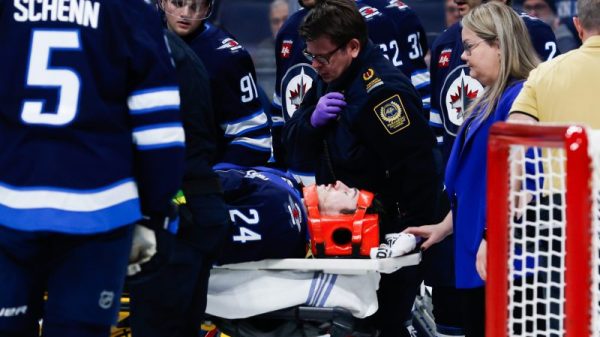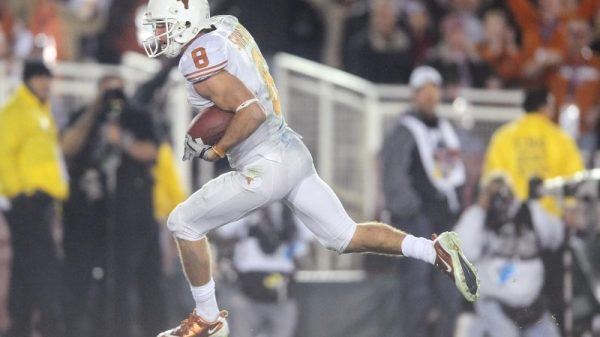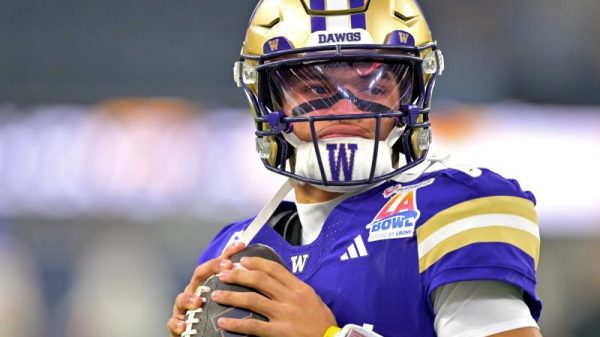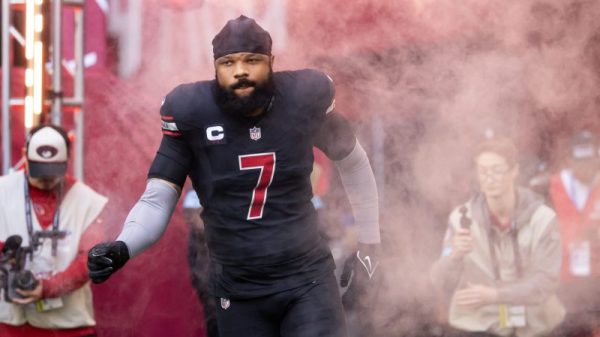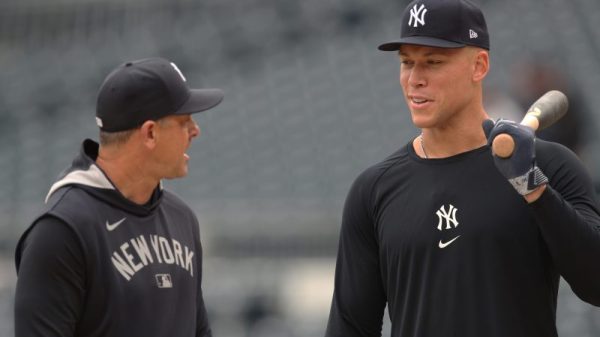During a college football game between Oklahoma and SMU in December 1985, ABC broadcaster Jim Lampley broke the news that star Indiana basketball guard and Olympic gold medalist Steve Alford had been suspended by the NCAA for one game against Kentucky after violating rules by posing in a Gamma Phi Beta sorority calendar.
The proceeds from calendar sales weren’t going to Alford’s pockets, but went to a sorority foundation in support of girls camps. That didn’t sway the NCAA in its ruling.
The response from legendary announcer Keith Jackson after Lampley’s report made clear his feelings about the NCAA and the Alford case.
‘That’s ridiculous,’ Jackson said. ‘That’s one of the problems they got. Ticky-tack everywhere you turn.’
Forty years later, the organization that is the face and enforcement arm of college athletics is still trying to regulate what athletes can do with their name, image and likeness amid an environment where a multitude of state laws and lack of federal legislation has forced schools to navigate the murky waters of name, image and likeness, a term that was virtually unspoken 20 years ago.
Follow every game: Latest NCAA College Football Scores and Schedules
USA TODAY Sports examined how two schools with some of the biggest brands in college football, Oklahoma and Ohio State, have taken a unique approach to handling the newest complex issues around compensation for college athletes.
Role of collectives
The newest catchword in college athletics is collectives, and depending on who you talk to collectives is nothing but a fancy word for booster and other parties that pool money in an effort to provide NIL compensation to players.
Boosters have been around for decades but are now playing a prominent role in seeing that athletes are compensated for generating the billions of dollars they do for institutions.
Oklahoma and Ohio State use collectives to make sure whether you are a star player or a benchwarmer that being part of a team means visibility for all. That involves getting the public, not just the wealthy boosters, involved in their efforts.
One of Ohio State’s collectives is called the Columbus NIL Club, which gives fans a chance to ‘financially support Ohio State student-athletes and join the ultimate fan experience’ and touts itself as an ‘athlete-led fan community.’
Charlie Grantham, director and associate professor for the Center of Sport Management at Seton Hall University, said while the schools are doing a service by helping the athlete earn compensation, they could do more and it’s under the guise of an inducement to play for their programs.
‘What they are trying to do is using the name, image and likeness as an advantage to matriculate to their program,’ Grantham said. ‘The biggest thing they don’t understand is that this was a strategic move and they had to give the athletes something because their backs are against the wall.’
The business of NIL
The NIL activities in athletic programs can be broken down into two factions: internal, where the school exclusively contracts with any potential business entity, and external, where an outside source of funding and the student-athlete work together on deals.
There are two university employees in the country whose job title it is to deal with NIL exclusively. One of them is former Oklahoma running back Rodney Anderson.
Anderson was drafted by the Cincinnati Bengals in the sixth round of the 2019 NFL draft despite tearing his ACL during his senior season with the Sooners. The Bengals waived Anderson in August 2020.
‘I was a little bit lost. I really didn’t know what my path was going to be just because everybody tells you athletes have that backup plan,’ the 26-year-old Anderson told USA TODAY Sports. After leaning on connections from his college days, he ended up with Sooners Sports Properties, a joint venture of Learfield, the school’s multimedia rightsholder.
Anderson is the manager of Oklahoma’s NIL business development and operations.
‘I think one of the biggest misconceptions about the student-athlete is that they are being paid and monetizing based on their reputation. Is it pay for play? And it’s not based on performance, or based on minutes played, points scored, but it is based on their reputation,’ said Toby Baldwin, Oklahoma’s executive associate athletic director/name, image, and likeness & operational advancement. ‘That’s why you see more focus on a Power Five school, a top 25 school, because we have a bigger brand.’
Baldwin says part of the job is twofold: Making sure that athletes who are sometimes receiving potentially generational wealth are prepared and getting resources, and people to help them understand things like taxation and financial planning.
‘Staying up to date on the latest laws and educating businesses, as well as know what they can and can’t do, you know how it works, dealing with an athlete, what that process looks like and then making sure that our partners know so that our student-athletes are protected,’ Anderson added.
While solicitations from every brand imaginable hit their inbox, Oklahoma steers away from doing deals that are bad for business, including pornography, alcohol, marijuana and gambling.
‘Just use your better judgment,’ Anderson says with a laugh when describing questionable deals. ‘I feel like our model is sustainable. I feel like what we’re doing is safe for the athletes and we’re focusing more on their brand rather than just the cash that is thrown at them. In the end, everybody wins.”
How deals are funneled through the university is a fairly simple process.
Most of the NIL deals involve use of the school’s name or logo. If a company wants use of that intellectual property, Learfield and Anderson get involved, hence the internal part of NIL.
If an athlete and a company are not using the property and doing a private, or external deal, as long as it meets with the standards set by the university, the consummated contract is simply uploaded online. The compliance office approves that contract and is responsible for ensuring that the athlete is doing services in return for promoting a product.
The education of NIL
Every school governs how and when deals with potential boosters, collectives and student-athletes get done, especially when it comes to the use of team specific logos, equipment and slogans. Protection of brands at each school is paramount, so as not to create an illusion that the school is endorsing a product that might not fit with its values and ideals.
‘A lot of the brands, when they decide they want to do an initial deal, they want to move quickly,’ Ohio State senior associate athletics director Carey Hoyt said. “So, it’s a lot of coordination and a lot of different units kind of having to pitch in to make it work.’
Hoyt coached Ohio State’s women’s gymnastics team for 13 years before joining the administrative side five years ago. She has additional responsibilities in sport administration and student-athlete development. That includes more than 1,000 student-athletes, 400 of them with at least one NIL deal. Over 1,200 deals were consummated during the 2021-2022 academic year alone, with football, women’s ice hockey and women’s volleyball leading the way.
And because the athletic department is so visible — especially the football program which has ranked consistently in the top 10 in the past decade — deals that student-athletes bring to the administration receive extra scrutiny.
At Ohio State, meetings with lawyers and compliance are a weekly occurrence. The group reviews any new issues that come up and looks at every deal in terms of philosophy. If there is one question concerning a wrong perception, that potential deal won’t make it past that meeting, regardless of how big the company is.
‘It’s been super interesting and very challenging at times,’ Hoyt said. ‘Trademark and licensing has felt the burden, just monitoring the use of our logo, compliance played a major role in deals.’
Hoyt stressed that the education of NIL is just as important as the deals that the university chooses to associate with.
‘We have something that’s called the circle of care. We have athletic trainers. We have mental health specialists, nutritionists and so many people that surround them. We view NIL as part of that circle of care,’ Hoyt said. ‘We want to make it easy for brands to connect with our student-athletes. It’s just brought a lot of these lessons to their lives earlier, which isn’t a bad thing necessarily. I think people are going to be better prepared for when they leave Ohio State.’
With any capitalist venture, some will be more prepared financially than others.
‘People don’t recognize that for regular students at Ohio State, whether you play the piano or are an artist, you have always had the ability to monetize your name, image and likeness,’ Hoyt said. ‘Student-athletes have not had that same opportunity, so this is just leveling the playing field. It’s not that new of a concept, it’s just new to athletes.
For Ohio State, if a company is interested in engaging with an athlete, they fill out a form asking simple questions, such as who they are interested in. But the most important question is whether they have a current partnership agreement with Ohio State Sports Properties/Learfield IMG College.
It is then up to the athlete and the company to come up with terms and how their partnership moves forward. The university doesn’t get involved unless the use of facilities or equipment is required, usually for a photo or television commercial shoot.






